Tech Vendors Prepare for Canada’s Move to E-Logs
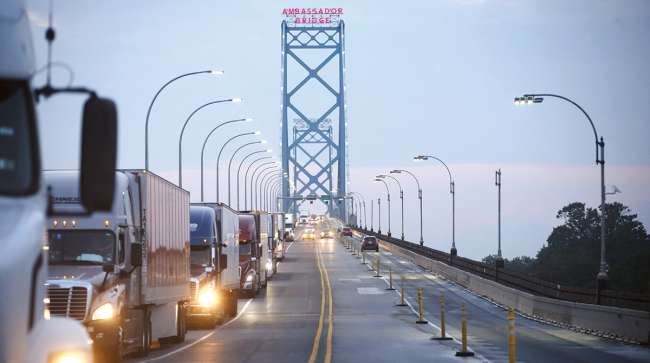
[Stay on top of transportation news: Get TTNews in your inbox.]
The trucking industry’s migration to federally mandated electronic logging devices is complete in the United States, but that transition is still a work in progress in Canada.
Although Canada’s ELD mandate took effect June 12, fleets and technology vendors are currently operating during a 12-month educational enforcement period. This phased-in approach to enforcement allows fleets to transition to ELDs without penalty until June 12, 2022.
The educational enforcement period was not part of the original plan, but no devices had been certified for use in the country when the regulation went into effect.

Q3 iTECH Stories
►Rise of the Smart Trailer
►Vendors Prep for E-Logs in Canada
►Fleets Find Ways to Harness Trailer Tracking Data
►Dysart: How Fleets Can Double Down on Ransomware Protection
►Clevenger: iTECH Has a New Look With a Familiar Feel
“Canada had a very hard start date of June 12, 2021. They didn’t make it because there were no devices for anybody to even install, so then they pushed this off 12 months,” said Mike Ahart, vice president of regulatory affairs at trucking technology firm Omnitracs.
Canada’s regulation, much like the U.S. mandate, requires motor carriers to install ELDs to automatically record drivers’ hours-of-service information instead of relying on paper logbooks.
But in Canada, ELD specifications vary slightly from those used in the United States. A third party must verify that the devices meet Canada’s regulatory and technical standards.
“A Canadian fleet may think if a device is certified in the U.S., it is certified in Canada, but it isn’t. If you’re operating in Canada, as long as you’re a federally registered carrier, you need that certification,” said Melanie Simard, compliance and safety specialist at ELD supplier Isaac Instruments.
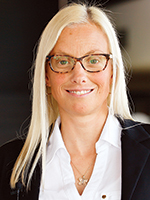
Simard
Simard said the certification process has been time-consuming.
“Last year we only had one certification body. There was a long waiting list for vendors. Now we are up to three certification bodies, but it is a whole new process,” she said, adding that the third party can interpret the technical standards differently than the vendor.
In addition to waiting on certification, vendors are closely watching how individual provinces adopt the ELD standard.
“It is a federal regulation, but it is up to the provinces to enforce rules. Some provinces adopt the federal rule by reference. Other provinces, such as Ontario and Quebec, take the federal rule and integrate it into their legislation and have a rule for federal and provincial carriers,” Simard explained. “The issue for fleets is they have to know which one is enforcing in which way.”
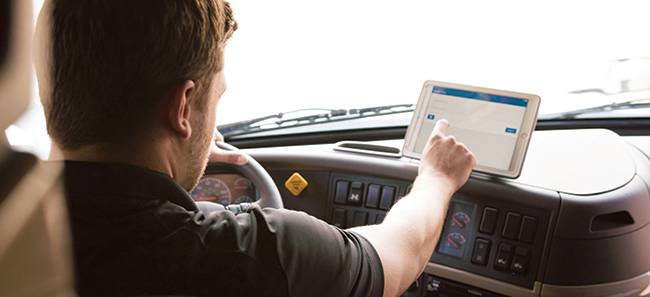
ELDs must account for different hours-of-service rules in the United States and Canada. (Geotab)
Fred Fakkema, vice president of safety and compliance at ELD supplier Zonar, said provinces agreed to adopt the requirements.
“We’re just waiting for those rules to be adopted,” he said. “If each province does something different, that may require a change.”
Omnitracs’ Ahart said there is concern Saskatchewan will not require ELDs for motor carriers operating within provincial borders.
“For ELD providers, this is important. We developed these in a way that requires some level of consistency,” he said.
Kerri Wirachowsky, director of roadside inspection at the Commercial Vehicle Safety Alliance, said educational enforcement currently consists of advising drivers to make sure their companies are working toward ELDs.
Heather Ness, transport operations editor at J. J. Keller & Associates Inc., said Alberta and Manitoba have indicated they may start issuing warnings after Dec. 31.
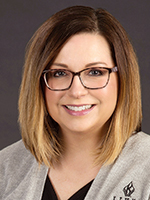
Ness
ELD Technical Specifications
The Canadian ELD rule does not change the country’s driver hours-of-service rules, just how drivers’ hours are recorded and tracked.
Much of the language is intended to provide parity between the U.S. and Canadian regulations, said Frank Stowers, product manager for Trimble Transportation.
However, it is important for cross-border trucking fleets to stay current on how the Canadian and U.S. mandates differ.
Scott Sutarik, vice president of commercial vehicle solutions at telematics provider Geotab, said data requirements and automatic records-of-duty creation are the same, but there are a few minor differences, such as how personal conveyance and yard moves work, how device malfunctions are handled and how drivers transfer a file during a roadside inspection.
Zonar’s Fakkema said that in the United States, the ELD transmits the information to the cloud and the enforcement officer accesses the data through electronic record of duty status software, also known as eRODS.
“Canada doesn’t have that, so a PDF gets sent to enforcement,” he said. “They can print the logs instead of viewing it on their computer, so there are certain requirements and fields that have to be there.”
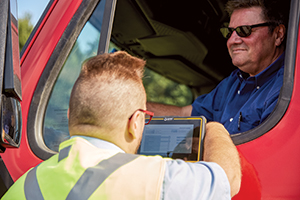
Current enforcement of Canada’s ELD rule focuses on education, with no penalties until June 12, 2022. (Isaac Instruments)
There is also a transition between miles and kilometers when a driver crosses the border, Fakkema added.
Canada’s rules on personal conveyance — driving a truck for personal use while off-duty — are stricter than the U.S. requirements.
“The driver must be off-duty, the vehicle must be empty, trailers must be unhitched and distance traveled during personal use is limited to 75 kilometers — 47 miles — per day,” J. J. Keller’s Ness said. “Once the distance limit is exceeded, personal use will no longer be available and any time after the initially allowed personal use will be logged as driving.”
In Canada, yard moves are still considered on-duty, not driving time. However, if the vehicle reaches 32 kph — about 20 mph — the ELD will automatically switch to driving, Ness said.
Canada also requires systems to give drivers a 30-minute warning before needed rest periods.
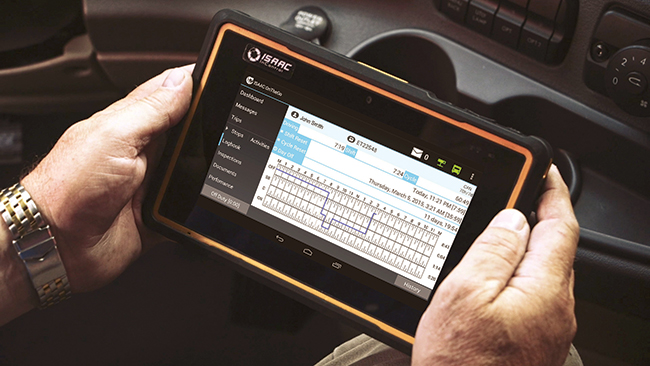
ELD suppliers such as Isaac Instruments are pursuing certification under Canada’s e-log rule. (Isaac Instruments)
Users can customize Isaac Instruments’ notifications to give drivers even more notice than the required 30 minutes, which Simard said can be useful for new drivers or drivers in areas with limited truck parking.
“You can base it on the area, the driver or the driver’s experience, and you can even push the notification to the dispatcher or the safety manager,” she said.
Cross-Border Hours of Service
ELDs use GPS to detect when a driver crosses the U.S.-Canada border.
“Upon crossing, drivers will need to change rule sets, which can be done manually or automatically,” Geotab’s Sutarik said.
Some systems require drivers to acknowledge the switch, which can be as easy as a touch of a button.
Fakkema said Zonar’s system has drivers accept the change for Canadian or U.S. hours of service.
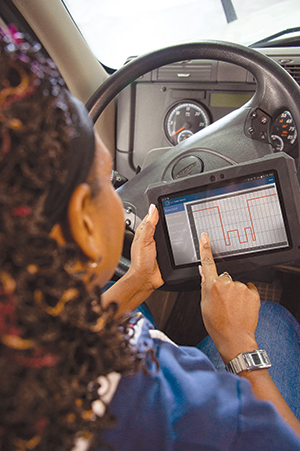
A driver views her hours-of-service data on an ELD. (J. J. Keller & Associates)
“We did that on purpose, so they know what their hours [are] and they aren’t going to go into violation,” he said.
In Canada, drivers have up to 13 hours of driving time after 8 consecutive hours off duty, compared with a maximum of 11 hours driving after 10 hours off in the United States.
“If the driver is only looking at his Canadian rule set, he is fine, but if he goes on the Detroit Bridge, he could get a violation,” Isaac’s Simard said, adding that drivers should confirm they have enough remaining time before reaching the border.
“We have a way for the driver to change the display of rule sets and say, ‘I know in five hours I’m going to be in the U.S. I want to make sure I’m going to be compliant so I don’t get a violation.’ ”
Searcy Trucking, a flatbed carrier based in Winnipeg, Manitoba, uses ELDs from Omnitracs.
Rachelle Baker, the fleet’s manager of driver services, said drivers have to give their approval when switching to a new hours-of-service rule set.
“There are a lot of things to do at the border, and the border crossings can be stressful,” she said. “The machine itself has been flawless.”

Fleet managers find that healthy, happy drivers are key to business success. Stephen Kane of Rolling Strong says driver health starts with “being vulnerable enough to listen to somebody that knows about health.” Hear a snippet above, and get the full program by going to RoadSigns.TTNews.com.
Searcy Trucking has been using ELDs since the end of 2019.
“We’re a little bit ahead of the game. Some of the smaller carriers and some Canadian carriers haven’t begun the homework,” Baker said.
Searcy Trucking is owned by Bison Transport, which ranks No. 57 on the Transport Topics Top 100 list of the largest for-hire carriers in North America.
Planning and Training
While it is challenging to prepare without knowing if a particular vendor will obtain Canadian ELD certification, J. J. Keller’s Ness said fleets shouldn’t be waiting around.
“Start talking with drivers,” she said. “Start planning how you might start rolling out ELDs once you have them. Plan on updating policies and procedures. Consider a pilot program with a provider, et cetera.”
It is important for fleets that are already using ELDs to ask if their provider is pursuing certification in Canada, she added. “If not, you’ll need to prepare to switch to a provider that is.”

Left: A Trimble in-cab device displays available drive time. (Trimble Transportation) Right: An Omnitracs device installed in a truck cab. (Omnitracs)
Fleets also need to know if their current provider is going to seek certification for all models or versions of their ELD products.
“Some vendors have a series of product, and they might only send two or three into certification,” Isaac’s Simard said.
Doug Schrier, senior vice president of strategy for Transflo, said the certification process is expensive so some smaller companies may not choose to pursue it.
“In order to get certified in Canada, you’re spending close to $100,000,” he said.
Baker, of Searcy Trucking, said fleets should give themselves plenty of time to train drivers on the devices.
Her company used online training tools and print, email and video correspondence to educate its drivers.
“We have just under 150 trucks and drivers here,” she said. “It made sense to get everybody current and on it as soon as we could.”
Want more news? Listen to today's daily briefing below or go here for more info:




